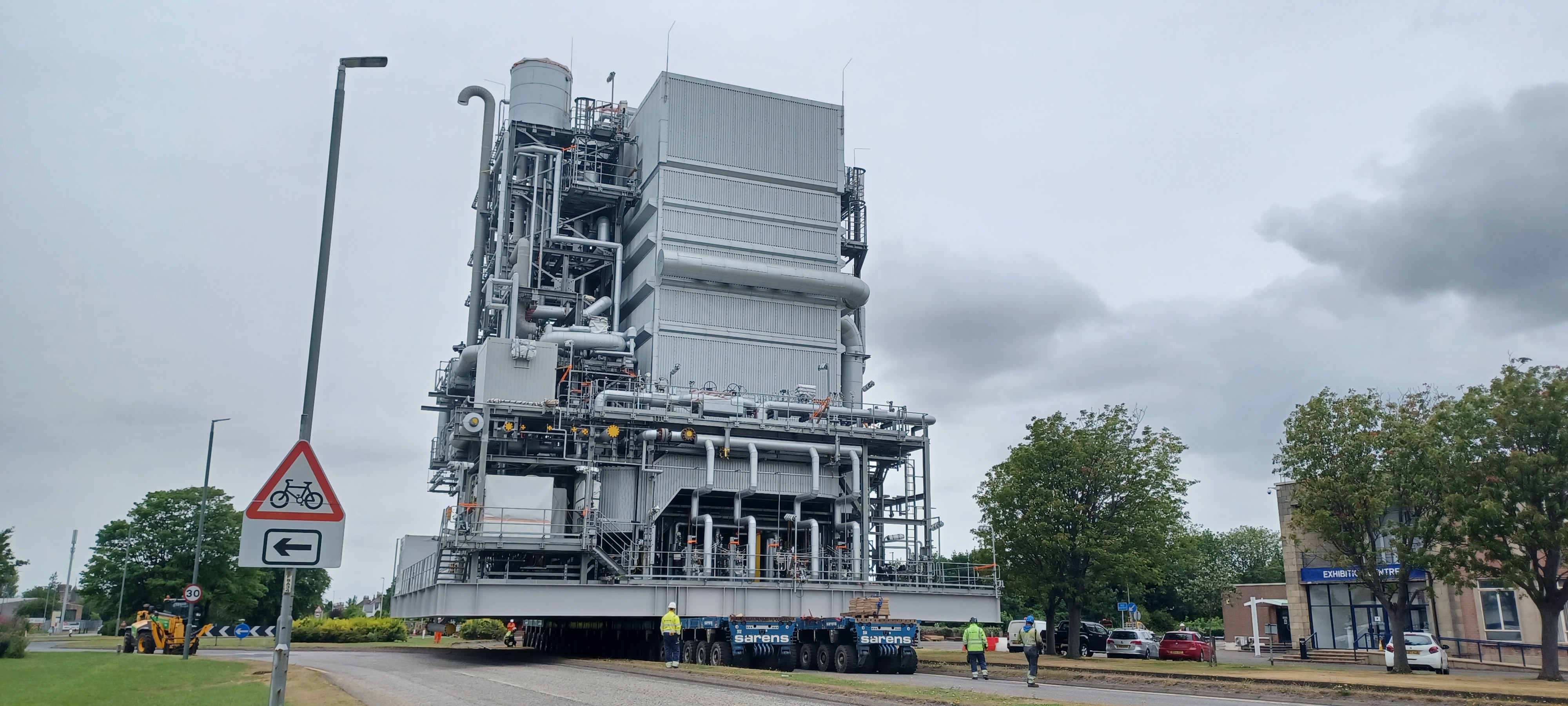
From April through August 2022, Sarens was responsible for loading in and transporting three 950T boiler units on behalf of global engineering and construction company Fluor. The operation was part of work at the INEOS plant in Grangemouth, Scotland, an integrated refinery and petrochemical plant that is one of INEOS’ largest manufacturing sites.
Sarens was previously involved in two other phases of this crucial boiler transport operation: the first involved loading out the three boiler units in Cadiz, Spain, so they could sail onward to a trans-shipment base in Rosyth, Scotland. Sarens then performed RORO operations, loading the three units from the ocean-going vessel and onto a towable barge, which allowed for delivery into the port of Grangemouth despite local lock restrictions.
Because Sarens was part of the load-in operation in Rosyth, the project team mobilised to two sites in parallel: one team, along with SPMTs and PPUs, mobilised to Rosyth, while another mobilised to the Port of Grangemouth to prepare to receive the cargo and store it on Sarens-supplied steel supports until it was needed on site. Because of this arrangement, Sarens could mobilise the SPMTs to Rosyth and then sail them, along with the cargo, to Grangemouth for load-in.
For the third and final phase of the operation at Grangemouth, axle loadings were restricted along main public roads, within the ports, and at the main site. This meant that Sarens had to provide dynamic and extensive engineering throughout the project, designing solutions to meet the client’s needs while adhering to local parameters.
To do it, Sarens deployed its signature engineering expertise, executing a plan that would rely on a 4-file, 25-axle line of K24 SPMTs. This configuration was rather long relative to the size of the cargo: the three boiler units weighed 950T each and measured 20x20x25 metres. It would, however, ensure that axle loadings remained below the maximum allowed. To further reduce transport length, power pack units were mounted on top of the SPMT deck, saving an extra four metres. Even so, transport stability was still right at the limits of engineering due to the load’s high centre of gravity and a narrow trailer set designed to accommodate subsequent cargo foundations at the installation location.
Selecting the right equipment and engineering solutions was only one part of the operation’s success: the rest was due to close cooperation with local authorities. Because the transport route from the port to the project site travelled through town, local roads had to temporarily be closed during the operation. This necessitated extensive planning with the local councils and police.
Finally, to navigate the many challenges along the route, Sarens had to engineer solutions like building transition platforms to bridge over obstacles like a newly-built traffic island. In this case, Sarens used its 2,75-metre long linkspan bridges to safely bridge a live gas pipeline. The biggest challenge, however, was bridging over a live pipe rack. For this, Sarens designed, supplied, and installed a bridging arrangement of Sarens modular bridging beams, which spanned 22,3 metres and allowed for transport up and over a 77-metre long ramp on both sides of the Sarens bridge.
With everything meticulously planned and prepared, Sarens successfully transported the three boiler units to the site, negotiating extremely tight conditions to ensure the cargo was delivered to the client safely and on time.
“One of the more involved engineering challenges was to review how the deflection in the trailers would impact the feasibility of the proposed heavy haul route (HHR),” said project engineer Andrew Cockshoot. “The route required the traversal of several obstacles: kerbs, slopes, traffic islands, and ultimately a 3,5-degree ramp to a bridge over an active pipe rack.”
“The transshipment operations gave us an opportunity to measure the SPMT deflections prior to transporting the load on the HHR,” Cockshoot said, “enabling us to re-run the engineering checks and ensure sufficient hydraulic stroke in the trailers was available to accommodate all the anticipated changes in level. These checks provided the working envelope of the transports that was communicated to the SPMT operators, who undertook the operation safely, successfully, and efficiently.”
Sarens is proud of the engineering ingenuity it took to pull off this exceptional operation, and would like to congratulate the team involved in making it a resounding success! Both the 16-strong UK site team and the Sarens Projects UK staff who provided countless hours of support are to be commended for a job well done!